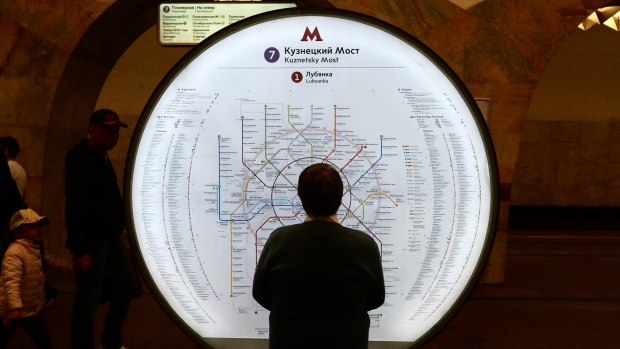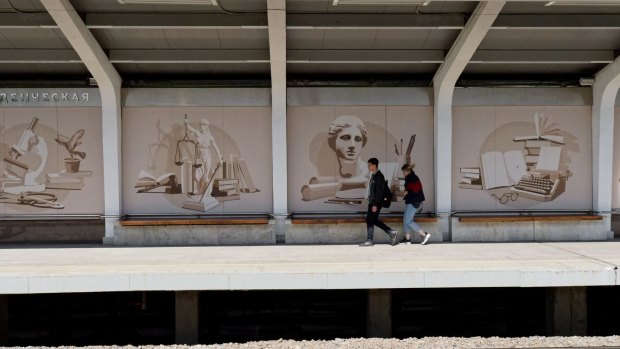This was published 4 years ago
Moscow's metro stations: Inside the world's most beautiful transport system
By Sue Williams
The voice sounds frantic in my earpiece. "Get on!" it shrieks. "Get on! Get on! Get on quickly!"
I scuttle onto the nearest carriage of the underground train, take a seat and nearly have the breath knocked out of me as it tears away at breakneck speed – up to around 80km/h, I'm later informed.
As it rattles through the blackness, I notice something strange about the carriage: almost bare, with absolutely no adverts on the walls. Maps of the system, yes, and treatises on the importance of further education, but no inducements to buy anything. At all.

A metro map at Kuznetskiy Most subway station.Credit: iStock
That same voice then breaks into my reverie. "Get ready to get off the train!" it orders as we slow towards a station. "Now, get off! Get off! GET OFF!"
It's hard work co-ordinating a tour by 25 people in Russia of the Moscow Metro but, with the help of an electronic earpiece that links to our APT guide's microphone, a loud voice and a manic edge of urgency to instructions, somehow it works.
We obediently get on and off trains and are treated at each destination to different, but equally exquisite, sights of what is widely acclaimed as the most beautiful transport system in the world. No fewer than 44 of the 263 stations on its total of 17 lines, criss-crossing the city for a length of nearly 400 kilometres, are listed as cultural heritage sites.

The platform of Studencheskaya metro station.Credit: iStock
And the pick of those stations – Kievskaya, Novoslobodskaya, Komsomolskaya, Kurskaya and Revolution Square– make the frenzied getting on and off all worthwhile with their great curving architecture, cavernous spaces, glowing pastel colours and chandeliers everywhere.
Building of the system started in 1935, with Stalin intending the stations to be underground "people's palaces", and many most certainly are. Even the journey down to the platforms are a revelation. Some of the stations go as deep as 84 metres underground, with dizzyingly long escalators carrying the crowds. It's always best to avoid glancing down. They also operate at about twice the speed of the leisurely Australian average, whizzing impatient Muscovites up and down with an efficiency that puts us to shame.
It's down on the platforms that the wonder really sets in. Many of the stations are decorated with colourful mosaics of Soviet-era revolutionary images and heroes, extolling the virtues of work, family and community.
Lenin bears down on commuters as they go about their business, trying to remind them of what is most important, while the power and the glory of the 1905 revolution, with strikes by workers, mutinies in the military and peasant uprisings, are all celebrated with a fervour that today looks almost whimsical.
Other walls are inset with intricate tile work, creating beautiful patterns designed to lift the hearts of the lumpen proletariat. Elsewhere, there are stained-glass panels, not of religious iconography but of socialist symbols, portraits and scenes with ubiquitous red flags flapping in the background. In some stations there are lamps jutting from the walls, shaped like victory torches, and beautiful artworks that might elsewhere be reserved for galleries, displaying bloody – but heroic – scenes of war triumphs.
As you stop to admire the images, passers-by nod at you, presumably proud of such high art in such ordinary, low places. So they should be. The workers at the stations are extraordinarily helpful, too. Another day when I visit without the tour guide and become hopelessly lost, one walks me a full 10 minutes up, down and around to a colleague who speaks a little English and can help.
By the time she hands me over, she is almost in tears. "I'm so sorry," she keeps saying. "I'm so sorry. No English."
And even more startling? A documented 99.96 per cent of the trains run on time.
TRIP NOTES
FLY
Various airlines, including Qatar, Emirates and Etihad, fly from Australia to Moscow, with one stop along the way. See qatarairways.com; emirates.com; etihad.com
CRUISE
The MS Valentina is one of 196-passenger river ships APT charters for its voyages. See aptouring.com.au
STAY
Rooms at Hotel Kempinski Baltschug Moscow start from $355. See kempinski.com/en/moscow/
MORE
Sign up for the Traveller Deals newsletter
Get exclusive travel deals delivered straight to your inbox. Sign up now.